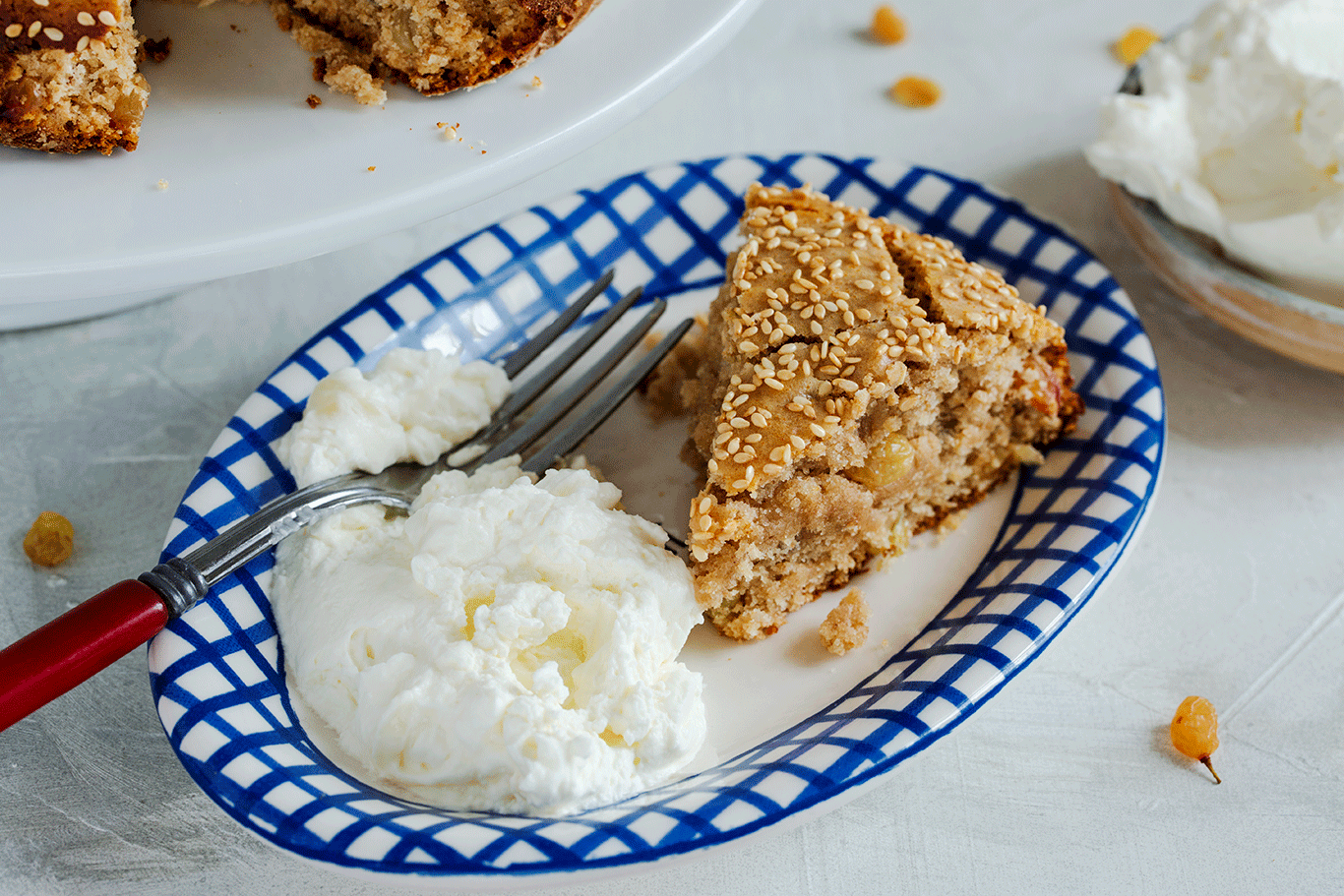Most people when they are in Greece, revel in its history and culture. I on the other hand, ogle food and food stuff; I love to eat Greek dishes which, for me as a Lebanese, are at the same time familiar and different. I also love the varieties of tahini one can find in the shops. Made with pounded sesame seeds which were previously soaked, peeled and roasted, tahini often replaces butter in sweet Eastern Mediterranean dishes. Maria Speck, this month’s guest blog writer, combines it with spelt flour to make a deliciously nutty and flavorful cake. Read the story and get the recipe below.
Maria who now lives in Massachusetts, was raised in Greece and Germany. The marriage of these two cultures has influenced her approach to food and cooking. She is a veteran journalist and has contributed to many publications such as Gourmet, Saveur and Gastronomica. Maria is the award-winning author of Simply Ancient Grains and Ancient Grains for Modern Meals.
Tahini from Greece for Life – by Maria Speck
Not long ago, the mere mention of tahini in the US would elicit blank stares from friends and food professionals alike. Today, thanks to our infatuation with all things Middle Eastern, this superb nut butter has become a household name. Not a day goes by that I don’t see a recipe for tahini dressing, tahini chocolate spread, or tahini breakfast rolls in magazines, newspapers, blogs, and on Instagram. Of course, world-renowned chef, restaurateur, and cookbook author Yotam Ottolenghi has been a driving force behind this trend that made us fall for many once obscure ingredients, including rose water, sumac, and labneh yogurt cheese.
I was raised on creamy tahini in my mother’s native Greece. And I am happy that I can use the sesame paste today without further explanation. Unlike naturally sweet almond or cashew butter, tahini adds complexity and character to recipes. Its signature aroma is unique, enveloping ingredients with a perplexing savory sweetness that I cherish.
You can safely call tahini the peanut butter of the Eastern Mediterranean and beyond—the super-nutritious spread is a staple in Greece, Turkey, Armenia, Lebanon, Israel, and is also used in Iran and Iraq. It shines in both sweet and savory recipes, from hummus to sweet rolls to toppings for meat and vegetables. During my childhood years in Greece, I could never get enough of it. We ate it by the spoonful or slathered it on sliced fresh bread with a drizzle of honey. My mom makes a signature peasant soup with nothing but chickpeas, cooked from scratch until almost fall-apart tender, adding an onion towards the end and waiting until it dissolves into the broth. To finish, she stirs in a dollop of tahini for rich creaminess, then cuts it with freshly squeezed lemon juice. To die for.
I have tried at least a dozen tahini brands over the years. So it almost broke my heart to read last summer in the New York Times that Ottolenghi couldn’t find a likeable Greek brand. Incidentally, I had one of the best sesame nut butters of my life last summer when visiting home—it was from Northern Greece.
Today, I stir tahini into spicy cumin-scented Greek yogurt sauce to enhance the aroma of nutty whole grain pasta (recipe in my second cookbook Simply Ancient Grains.). Or I make a honey tahini spread, inspiring others on Instagram. And I use it all the time in baking as in the Honey Tahini Cake with Spelt below.
This easy two-bowl cake has roots in both of my native cultures. Tahini cakes and pies are a standby in Greece and spelt is traditionally used in southern Germany where I spent my formative years. Now I very much hope that Yotam will continue to taste tahini, including from Greece.
Honey Tahini Cake with Spelt
My recipe for this tahini cake, published in Simply Ancient Grains, was inspired by a creation by celebrated Greek pastry chef Stelios Parliaros. I use whole grain spelt flour instead of all-purpose and macerate the dried fruits in tangy Limoncello liqueur. Incidentally, this nourishing cake is naturally vegan, without eggs and butter.
I have since taken it in a new direction by swapping out the confectioners’ sugar for honey and using much less of it. I love this new take even more as honey complements the natural mild sweetness of spelt, creating a superb wholesome dessert. If you have an extra minute, Greek Yogurt Cream (below) makes it special.
Ingredients
- Butter, for the pan
- 130 g (1 cup) finely chopped dried fruits (see Fine Points)
- 30 g (2 tablespoons) Limoncello, brandy, or water
- 200 g (about 1 3/4 cups) whole grain spelt, plus extra for the pan
- 1 1/4 teaspoons baking powder
- 1/4 teaspoon fine sea salt
- 150 g (about 1/2 cup plus 2 tablespoons) well-stirred tahini
- 150 g (about 1/3 cup plus 2 tablespoons) honey
- 160 g water (about 3/4 cup minus 1 tablespoon) water, at room-temperature
- 1 tablespoon sesame seeds, for sprinkling (optional)
- Icing sugar (confectioners’ sugar), for dusting
Method
- Position a rack in the center of the oven and preheat to 325°F/ 160°C. Lightly butter a 9-inch round metal baking pan. Line the bottom with parchment paper and lightly butter the paper as well. Dust the pan with flour, tapping out excess.
- Combine the dried fruit and the liqueur in a small bowl and set aside to plump a bit while you prep the ingredients, stirring once or twice.
- Whisk together the flour, baking powder, and salt in a large bowl. Make a well in the center. In a medium bowl, whisk the tahini, honey, and water to combine—it will look broken initially—then whisk vigorously until very smooth and glistening, 1 to 2 minutes, depending on the viscosity of your tahini and honey.
- Pour thetahini mixture into the center of the flour mixture, and starting from the center, gently whisk to combine. A few streaks of flour can remain at this stage. Using a spatula, fold in the plumped dried fruit, including any liquid. The batter should be creamy with a thick pourable consistency. Gently stir in 1 or 2 tablespoons more flour if too liquid or, if too dry, a tablespoon or so more water. Scrape the batter into the pan, evening out the top and gently spreading it into the corners. Sprinkle with the sesame seeds.
- Bake until the cake barely starts to brown around the edges, and a cake tester or toothpick inserted into the center comes out clean, about 30 minutes.
- Transfer the pan to a wire rack to cool for 10 minutes. Loosen the cake around the edges with a paring knife. Invert the cake onto a small tray or flat plate, remove the parchment paper, and carefully return the cake right-side up to the wire rack to cool completely. When ready to serve, sprinkle lightly with confectioners’ sugar. Cut with a long sharp knife, dipped into hot water and wiped clean between each cut, into 8 to 12 wedges.
Greek Yogurt Cream
Ingredients
- 250 g (about 1 cup) heavy whipping cream
- 125 g (about 1/2 cup) whole or low-fat Greek yogurt
- 40 g (2 tablespoons) honey, or to taste
Method
Add the cream, yogurt, and honey to a medium bowl and beat, by hand or with an electric mixer, until soft peaks form. Serve, dolloped next to a slice of cake.
Fine Points
I you have a sweet a sweet tooth, use 200 g (instead of 150g) honey and 110 g (instead of 160g) water.
- A number of excellent tahini brands are available in the US. For all my baking, I like the organic Whole Foodsbrand; it is lightly roasted and the natural oil that typically separates can easily be stirred back, making it great for baking. Also, I prefer brands that grind the sesame seeds with the nutritious hulls, adding natural bitter compounds for complex aroma. But these are personal choices and I recommend you try as many brands as you can.
- A combination of candied lemon peel with currants adds beautiful complexity to this cake but only if you can get something other than supermarket-brand peel, which is often one-dimensional and cloyingly sweet. Otherwise try combining tangy Blenheim apricots with currants or dried figs, or prunes and dried figs.
- Make Ahead: This cake can be baked 1 day ahead—its flavor will only intensify. Store in an airtight container or under a cake dome at room temperature.
Cake recipe adapted from Simply Ancient Grains (Ten Speed Press) by Maria Speck.
Baking time
Preparation time
Serves





Leave a Reply
Want to join the discussion?Feel free to contribute!